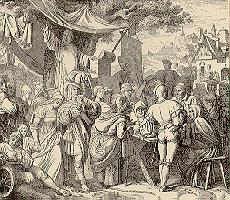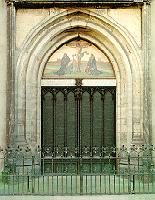The 95 Theses and their Results (1517-1519)
Background
From 1514 Luther was not only theology professor at Wittenberg University but also the priest at the City Church in Wittenberg. So he was also responsible for the salvation of his parish.
 Luther observed that many people in Wittenberg were not coming to him for confession any more. They were going to towns in Brandenburg or Anhalt like Jüterbog or Zerbst to buy Indulgences (primarily the Peter's Indulgence).
Luther observed that many people in Wittenberg were not coming to him for confession any more. They were going to towns in Brandenburg or Anhalt like Jüterbog or Zerbst to buy Indulgences (primarily the Peter's Indulgence).
The practice of buying indulgences, which quasi replaced confession and allowed people to buy their salvation, was completely repulsive to Luther. He strongly believed that one lived a life of humility in order to receive God's grace.
After 1507, trade in Indulgences took a steep climb because both the Papal Court and Bishop Albrecht von Brandenburg Germany's representative for the sale of indulgence were in great financial trouble.
In addition, the Dominican monk, Johann Tetzel, sold indulgences in the region around Wittenberg in a very ostentatious manner. Many stories started poping up about him such as, that Tetzel could redeem the sins of the deceased.
Further sayings of Tetzel, such as, "When the money clangs in the box, the souls spring up to heaven", also brought protests from Luther.
October 31, 1517, "Nailing the 95 Theses to the Door of the Castle Church"
 Prior to October 31, 1517, Luther had preached against the indulgence trade. After reading an instruction manual for indulgence traders, he wrote a letter to his church superiors hoping to get rid of this abuse. In this letter he included 95 Theses which were to be used as the basis for a discussion on the topic.
Prior to October 31, 1517, Luther had preached against the indulgence trade. After reading an instruction manual for indulgence traders, he wrote a letter to his church superiors hoping to get rid of this abuse. In this letter he included 95 Theses which were to be used as the basis for a discussion on the topic.
That Luther hammered his theses to the door of the Castle Church in Wittenberg belongs to the realm of legends (the legend of Nailing the 95 Theses to the Door of the Castle Church).

Reactions to the 95 Theses
Luther sent his 95 Theses to a few bishops and some friends; therefore he did not expect or receive a prompt response. By the end of 1517, however, copies of the 95 Theses had been printed in Leipzig, Nuremberg and Basel. Some humanists and princes passionately approved of the theses, but parts of the Roman Church completely rejected them. The most vehement voice against the theses was the Indulgence Priest Tetzel, who supposedly categorized Luther as a follower of the heretic Jan Hus and threatened to have him burned at the stake.At first the bishops reacted mildly, they informed the Pope of the 'rebel within the ranks' and instructed Luther's direct superior to take a moderate roll in calming him. A few bishops actually welcomed Luther's ideas for reform.
Events up to 1519
Because of increasing pressure, Luther found it necessary to explain and clarify his theses in writing. In 1518, Luther himself said that he only wanted to take care of an abuse (indulgence) and was not striving to unhinge the papacy with his theses.The avalanche, however, was now unstoppable. The Papal Court reacted drastically to the alleged heretic and in 1518 an inquisition was begun in Rome. This quieted down in 1519 during the search for a successor to the deceased Emperor Maximilian. Once Karl the V was elected as emperor, the fight against Luther and his followers continued.